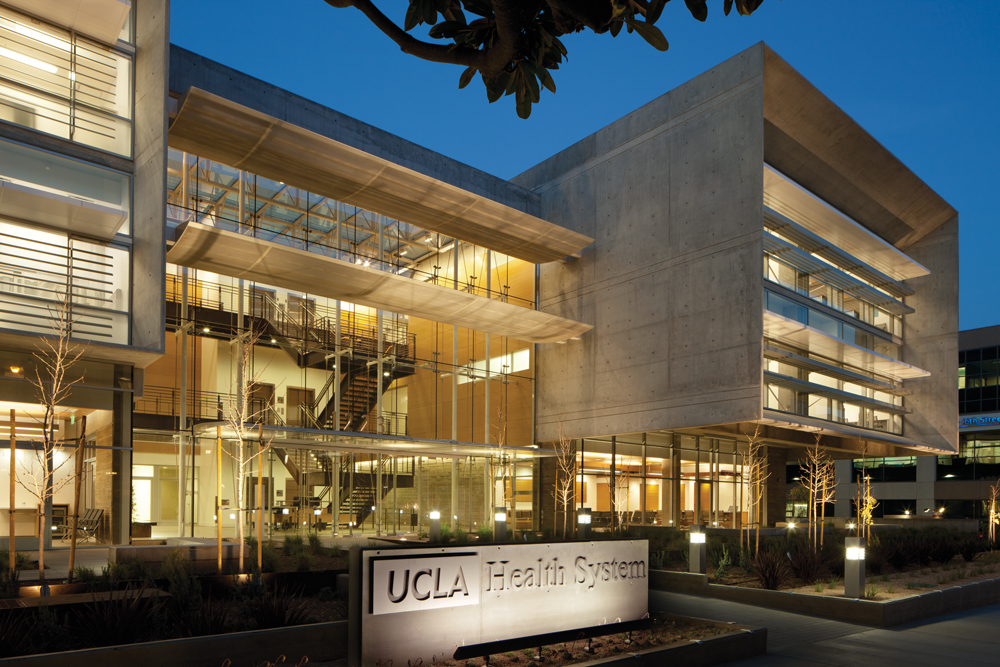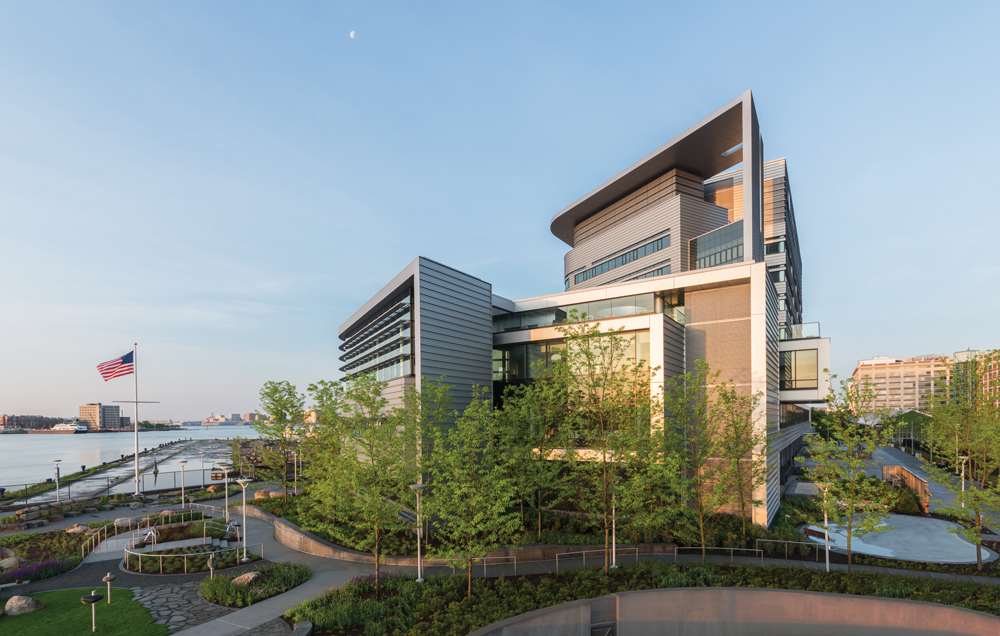LEED for Healthcare debuted in spring 2011, and certifications are now beginning to roll in. The first LEED-HC certified project, Group Health Cooperative’s new Puyallup (Wash.) Medical Center, is an outpatient site designed by CollinsWoerman, which opened at the end of 2012. The 53,000-sf project incorporates Lean design principles and the increasingly popular “medical home” concept; it was certified Gold this past April.
LEED-HC is the first of the LEED rating systems to institutionalize a prerequisite for Integrated Project Planning and Design, as well as an available credit for advanced coordination. These factors helped the Puyallup team—including GLY Construction and design-build MEP partners UMC, Prime Electric, and Patriot Fire Protection—rack up six Innovation points. In addition, the building earned credits in the new categories Connection to the Natural World, Water Use Reduction (medical equipment cooling), Community Contaminant Prevention/Airborne Releases, and PBT (persistent bioaccumulative toxins) Source Reduction.
Hot on the heels of Group Health’s win came the first LEED-HC Platinum certification: The W.H. and Elaine McCarty South Tower at Dell Children’s Medical Center of Central Texas, in Austin. The main Dell building became the world’s first LEED-NC Platinum-certified hospital in 2008, and the McCarty project, a 72-bed tower offering special services in epilepsy management and pediatric rehab, builds on the green track record established by owner Seton Healthcare Family.
Greenbuild coverage of Healthcare Firms brought to you by:
Important aspects of the certification included waste reduction and diversion, sustainable sourcing of materials, water efficiency, and avoidance of materials with known negative health effects. An advanced thermal envelope, high-efficiency glazing, reduced interior lighting power density (aided by copious use of LEDs), an enthalpy wheel, and photovoltaic systems augmented an important built-in benefit of the site: a district energy heating and cooling system with a co-generation plant.
The Building Team, led by contractor The Beck Group, also scored six Innovation points, including two LEED-HC pilot credits involving reduction of PBTs and phthalates. To earn these credits, the team had to be particularly careful to spec materials, furniture, and equipment that do not contain mercury, lead, cadmium, copper, and other suspect chemicals.
Methodist Olive Branch (Miss.) Hospital is also enrolled in LEED-HC and is targeting Gold certification. The 100-bed, 210,000-sf project opened in August and is the first hospital in the nation to use dynamic photoelectric glazing, which is manufactured by View Inc. in a nearby factory. The product was installed in the two-story lobby to reduce energy needs for heating and cooling.
The hospital also has a geothermal heat pump system encompassing 206 units, including one in each patient room. “Our designers created special soundproof closets to house the pumps, allowing patients to enjoy individualized climate control and a consistently quiet, calming atmosphere,” says Greg Gore, AIA, NCARB, Principal at Gresham, Smith and Partners. Using IPD, Gresham, Smith and its Building Team partners Smith Seckman Reed and Turner Construction designed and built the project in 23 months.
The 132-bed Spaulding Rehabilitation Hospital was built on a brownfield parcel in the Charlestown (Mass.) Navy Yard, opening just in time to serve victims of the Boston Marathon bombing. Resiliency planning included placement of HVAC infrastructure on the roof rather than underground or at ground level. Vegetated roofs mitigate stormwater runoff and reduce cooling loads and the heat island effect. On the third and fourth floors, therapeutic terraces help patients and their families stay connected with the natural environment. On the Building Team: Perkins+Will (architect), Thompson Consultants and Buro Happold Consulting Engineers (MEP), McNamara/Salvia (SE), Vanasse Hangen Brustlin (CE), Copley Wolff Design Group (landscape architect), Haley & Aldrich (environmental/geotechnical), and Walsh Brothers (CM). PHOTO: © JAMES STEINKAMP PHOTOGRAPHY
Among the first large government projects enrolled in LEED-HC is a VA Healthcare Center under way in Kernersville, N.C., anticipating Gold certification. Lend Lease Healthcare is designing, building, and managing the $150 million, 280,000-nsf facility in collaboration with architect Perkins Eastman. The center will support area veterans with primary care, plus mental health, dental, diagnostic, laboratory, pathology, radiology, and ancillary services.
A few unusual sustainable strategies will be thrown into the mix, along with standards such as daylighting, high-efficiency HVAC, and a green roof. A stormwater retention pond will be landscaped with native species and will use a windmill for aeration, eliminating the need for electrically powered pumps. The windmill is planned as a distinctive centerpiece for a rehabilitation activity pathway that will circle the pond, fitting LEED-HC’s emphasis on patients’ connection to the outdoors.
On the opposite coast, the UCLA Outpatient Surgery and Medical Building, in Santa Monica, is slated for Gold under LEED-NC. Winner of a 2013 National Healthcare Design Award from the AIA Academy of Architecture for Health in the Built category, the facility was designed to facilitate linkages between the community and UCLA’s medical students and faculty.
The building provides eight operating rooms for outpatient surgery, oncology treatment facilities (including two linear accelerators), a pharmacy, and academic and medical offices. The generous number of ORs was intended to help relieve strain on inpatient facilities at the nearby UCLA Medical Center.
Michael W. Folonis Architects created the 50,000-sf building to interface with an automated underground parking lot, which uses cranes to stage up to 250 vehicles in and out of a parking lobby. The equipment greatly reduces the need for lighting and HVAC that would normally be required for a parking garage, as well as the environmental impact of idling vehicles. Additional green features include passive solar design plus extensive PV arrays, recycled and sustainable materials (notably, a large amount of bamboo flooring and walls), and water-conserving fixtures and landscaping.
Methodist Olive Branch Hospital is on track for LEED-HC Gold. The Mississippi hospital includes two sustainable technologies that are unusual for inpatient facilities: photochromic glass, which is manufactured in a local factory, and geothermal heat pumps, with each patient room served by its own unit. “Our team was committed to providing a new hospital that would play a vital role in the community and that would also reflect our organization’s commitment to building innovative, sustainable facilities,” says David Rosenbaum, VP/Facility Management, Methodist Le Bonheur Healthcare. PHOTO: JEFFREY JACOBS
With high-profile stories of healthcare facilities strained by extreme weather events such as Superstorm Sandy and the Joplin, Mo., tornado, resiliency is also becoming a priority for the sector. Green thinking incorporates life cycle considerations, since deterioration, destruction, and reconstruction always entail some negative environmental impacts.
Spaulding Rehabilitation Hospital in Charlestown, Mass., exemplifies the resiliency trend. The 262,000-sf LEED Gold building, designed by Perkins+Will, was built on a remdiated brownfield parcel in the Charlestown Navy Yard. To protect infrastructure from any future rises in sea level, the main floor was raised a foot above ground level, and all HVAC equipment was located on the roof. Automatic operable windows were provided to the three-story wing that houses the therapeutic gym and pool, which has systems separate from those in the bed tower. The windows will provide ventilation even in times of power outages.
Patient room windows can also be operated on an emergency basis, and owner Partners HealthCare is measuring the effects of opening windows in some controlled zones to determine possible effects on air quality, with an eye toward future projects.
The LEED-NC Gold Benjamin Russell Hospital for Children at Children’s of Alabama, Birmingham, is the nation’s third-largest pediatric hospital, encompassing 772,000 sf, 248 beds, and 48 NICU bassinets. Green strategies include daylighting, a rooftop healing garden, and use of air-conditioning condensate for landscape irrigation and equipment cooling. Salvaged materials from the demolition of two existing buildings were incorporated. The Building Team: KLMK Group (project manager), HKS Inc. in partnership with Giattina Aycock Studio (architects), HKS Inc. (interiors, SE, programming), ccrd (MEP), Walter Schoel Engineering Co. (CE), Macknally Land Design (landscape architect), and Hoar Construction in partnership with BE&K (CM). PHOTO: HKS
Related Stories
| Aug 11, 2010
Wisconsin becomes the first state to require BIM on public projects
As of July 1, the Wisconsin Division of State Facilities will require all state projects with a total budget of $5 million or more and all new construction with a budget of $2.5 million or more to have their designs begin with a Building Information Model. The new guidelines and standards require A/E services in a design-bid-build project delivery format to use BIM and 3D software from initial ...
| Aug 11, 2010
News Briefs: GBCI begins testing for new LEED professional credentials... Architects rank durability over 'green' in product attributes... ABI falls slightly in April, but shows market improvement
News Briefs: GBCI begins testing for new LEED professional credentials... Architects rank durability over 'green' in product attributes... ABI falls slightly in April, but shows market improvement
| Aug 11, 2010
Luxury Hotel required faceted design
Goettsch Partners, Chicago, designed a new five-star, 214-room hotel for the King Abdullah Financial District (KAFD) in Riyadh, Saudi Arabia. The design-build project, with Saudi Oger Ltd. as contractor and Rayadah Investment Co. as developer, has a three-story podium supporting a 17-story glass tower with a nine-story opening that allows light to penetrate the mass of the building.
| Aug 11, 2010
U.S. firm designing massive Taiwan project
MulvannyG2 Architecture is designing one of Taipei, Taiwan's largest urban redevelopment projects. The Bellevue, Wash., firm is working with developer The Global Team Group to create Aquapearl, a mixed-use complex that's part of the Taipei government's "Good Looking Taipei 2010" initiative to spur redevelopment of the city's Songjian District.
| Aug 11, 2010
Restoration gives new life to New Formalism icon
The $30 million upgrade, restoration, and expansion of the Mark Taper Forum in Los Angeles was completed by the team of Rios Clementi Hale Studios (architect), Harley Ellis Devereaux (executive architect/MEP), KPFF (structural engineer), and Taisei Construction (GC). Work on the Welton Becket-designed 1967 complex included an overhaul of the auditorium, lighting, and acoustics.
| Aug 11, 2010
Best AEC Firms to Work For
2006 FreemanWhite Hnedak Bobo Group McCarthy Building Companies, Inc. Shawmut Design and Construction Walter P Moore 2007 Anshen+Allen Arup Bovis Lend Lease Cannon Design Jones Lang LaSalle Perkins+Will SmithGroup SSOE, Inc. Timothy Haahs & Associates, Inc. 2008 Gilbane Building Co. HDR KJWW Engineering Consultants Lord, Aeck & Sargent Mark G.
| Aug 11, 2010
High-Performance Workplaces
Building Teams around the world are finding that the workplace is changing radically, leading owners and tenants to reinvent corporate office buildings to compete more effectively on a global scale. The good news is that this means more renovation and reconstruction work at a time when new construction has stalled to a dribble.
| Aug 11, 2010
Great Solutions: Business Management
22. Commercial Properties Repositioned for University USE Tocci Building Companies is finding success in repositioning commercial properties for university use, and it expects the trend to continue. The firm's Capital Cove project in Providence, R.I., for instance, was originally designed by Elkus Manfredi (with design continued by HDS Architects) to be a mixed-use complex with private, market-...












